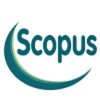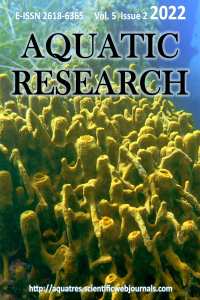Research Article
Aim & Scope
“AQUATIC RESEARCH" journal publishes peer-reviewed articles covering all aspects of
Aquatic Biology, Aquatic Ecology, Aquatic Environment and Pollutants, Aquaculture, Conservation and Management of Aquatic Source, Economics and Managements of Fisheries, Fish Diseases and Health, Fisheries Resources and Management, Genetics of Aquatic Organisms, Limnology, Maritime Sciences, Marine Accidents, Marine Navigation and Safety, Marine and Coastal Ecology, Oseanography, Seafood Processing and Quality Control, Seafood Safety Systems, Sustainability in Marine and Freshwater Systems
in the form of research, short communication, and review articles. Peer-reviewed open access journal publishes articles quarterly in English or Turkish language and have not submission, processing or publication charges (cost free).
Author Guidelines
Journal abbreviation: Aquat Res
e-ISSN: 2618-6365
Submit your article with online: http://dergipark.gov.tr/journal/2277/submission/start
Instructions to Authors
The editorial and publication processes of the journal are shaped in accordance with the guidelines of the Committee on Publication Ethics (COPE), the European Association of Science Editors (EASE), the International Council of Medical Journal Editors (ICMJE), and National Information Standards Organization (NISO). The journal conforms to the Principles of Transparency and Best Practice in Scholarly Publishing (https://doaj.org/bestpractice).
Originality, high scientific quality, and citation potential are the most important criteria for a manuscript to be accepted for publication. Manuscripts submitted for evaluation should not have been previously presented or already published in an electronic or printed medium. The journal should be informed of manuscripts that have been submitted to another journal for evaluation and rejected for publication. The submission of previous reviewer reports will expedite the evaluation process. Manuscripts that have been presented in a meeting should be submitted with detailed information on the organization, including the name, date, and location of the organization.
Manuscripts submitted to “Aquatic Research” will go through a double-blind peer-review process. Each submission will be reviewed by at least two external, independent peer reviewers who are experts in their fields in order to ensure an unbiased evaluation process. The editorial board will invite an external and independent editor to manage the evaluation processes of manuscripts submitted by editors or by the editorial board members of the journal. The Editor in Chief is the final authority in the decision-making process for all submissions.
An approval of research protocols by the Ethics Committee in accordance with international agreements (World Medical Association Declaration of Helsinki “Ethical Principles for Medical Research Involving Human Subjects,” amended in October 2013, www.wma.net) is required for experimental, clinical, and drug studies. If required, ethics committee reports or an equivalent official document will be requested from the authors.
For manuscripts concerning experimental research on humans, a statement should be included that shows the written informed consent of patients and volunteers was obtained following a detailed explanation of the procedures that they may undergo. Information on patient consent, the name of the ethics committee, and the ethics committee approval number should also be stated in the Materials and Methods section of the manuscript. It is the authors’ responsibility to carefully protect the patients’ anonymity. For photographs that may reveal the identity of the patients, signed releases of the patient or of their legal representative should be enclosed.
“Aquatic Research” journal requires experimental research studies on vertebrates or any regulated invertebrates to comply with relevant institutional, national and/or international guidelines. The journal supports the principles of Basel Declaration (https://www.basel-declaration.org/) and the guidelines published by International Council for Laboratory Animal Science (ICLAS) (http://iclas.org/). Authors are advised to clearly state their compliance with relevant guidelines.
“Aquatic Research” journal advises authors to comply with IUCN Policy Statement on Research Involving Species at Risk of Extinction and the Convention on the Trade in Endangered Species of Wild Fauna and Flora for research involving plants.
All submissions are screened by a similarity detection software (iThenticate).
In the event of alleged or suspected research misconduct, e.g., plagiarism, citation manipulation, and data falsification/ fabrication, the Editorial Board will follow and act in accordance with COPE guidelines.
Each individual listed as an author should fulfil the authorship criteria recommended by the ICMJE. The ICMJE recommends that authorship be based on the following 4 criteria:
1. Substantial contributions to the conception or design of the work; or the acquisition, analysis, or interpretation of data for the work; AND
2. Drafting the work or revising it critically for important intellectual content; AND
3. Final approval of the version to be published; AND
4. Agreement to be accountable for all aspects of the work in ensuring that questions related to the accuracy or integrity of any part of the work are appropriately investigated and resolved.
In addition to being accountable for the parts of the work he/she has done, an author should be able to identify which co-authors are responsible for specific other parts of the work. In addition, authors should have confidence in the integrity of the contributions of their co-authors.
All those designated as authors should meet all four criteria for authorship, and all who meet the four criteria should be identified as authors. Those who do not meet all four criteria should be acknowledged in the title page of the manuscript.
“Aquatic Research” journal requires corresponding authors to submit a signed and scanned version of the authorship contribution form (available for download through https://dergipark.org.tr/en/download/journal-file/19583) during the initial submission process in order to act appropriately on authorship rights and to prevent ghost or honorary authorship. If the editorial board suspects a case of “gift authorship,” the submission will be rejected without further review. As part of the submission of the manuscript, the corresponding author should also send a short statement declaring that he/she accepts to undertake all the responsibility for authorship during the submission and review stages of the manuscript.
“Aquatic Research” journal requires and encourages the authors and the individuals involved in the evaluation process of submitted manuscripts to disclose any existing or potential conflicts of interests, including financial, consultant, and institutional, that might lead to potential bias or a conflict of interest. Any financial grants or other support received for a submitted study from individuals or institutions should be disclosed to the Editorial Board. To disclose a potential conflict of interest, the ICMJE Potential Conflict of Interest Disclosure Form should be filled in and submitted by all contributing authors. Cases of a potential conflict of interest of the editors, authors, or reviewers are resolved by the journal’s Editorial Board within the scope of COPE and ICMJE guidelines.
The Editorial Board of the journal handles all appeal and complaint cases within the scope of COPE guidelines. In such cases, authors should get in direct contact with the editorial office regarding their appeals and complaints. When needed, an ombudsperson may be assigned to resolve cases that cannot be resolved internally. The Editor in Chief is the final authority in the decision-making process for all appeals and complaints.
“Aquatic Research” journal requires each submission to be accompanied by a Copyright Transfer Form
(available for download at https://dergipark.org.tr/en/download/journal-file/19583).
When using previously published content, including figures, tables, or any other material in both print and electronic formats, authors must obtain permission from the copyright holder. Legal, financial and criminal liabilities in this regard belong to the author(s).
Statements or opinions expressed in the manuscripts published in “Aquatic Research” journal reflect the views of the author(s) and not the opinions of the editors, the editorial board, or the publisher; the editors, the editorial board, and the publisher disclaim any responsibility or liability for such materials. The final responsibility in regard to the published content rests with the authors.
MANUSCRIPT PREPARATION
The manuscripts should be prepared in accordance with ICMJE-Recommendations for the Conduct, Reporting, Editing, and Publication of Scholarly Work in Medical Journals (updated in December 2017 - http://www.icmje.org/icmje-recommendations.pdf). Authors are required to prepare manuscripts in accordance with the CONSORT guidelines for randomized research studies, STROBE guidelines for observational studies, STARD guidelines for studies on diagnostic accuracy, PRISMA guidelines for systematic reviews and meta-analysis, ARRIVE guidelines for experimental animal studies, TREND guidelines for non-randomized studies, and COREQ guidelines for qualitative studies.
Manuscripts can only be submitted through the journal’s online manuscript submission and evaluation system, available at http://dergipark.gov.tr/journal/2277/submission/start
Manuscripts submitted to the journal will first go through a technical evaluation process where the editorial office staff will ensure that the manuscript has been prepared and submitted in accordance with the journal’s guidelines. Submissions that do not conform to the journal’s guidelines will be returned to the submitting author with technical correction requests.
Authors are required to submit the following forms during the initial submission.
· Copyright Transfer Form,
· Author Contributions Form (https://dergipark.org.tr/en/download/journal-file/19583),
· ICMJE Potential Conflict of Interest Disclosure Form (should be filled in by all contributing authors) Download this form
from http://www.icmje.org/conflicts-of-interest/ fill and save. Send this to the journal with your other files.
Preparation of the Manuscript
Manuscripts prepared in Microsoft Word must be converted into a single file before submission. Please start with the title page and insert your graphics (schemes, figures, etc.), tables in the main text.
Title (should be clear, descriptive and not too long)
Full Name(s) and Surname (s) of author(s)
ORCID ID for all author (s) (http://orcid.org/)
Address (es) of affiliations and e-mail (s)
Complete correspondence address and e-mail
Abstract
Key words (indexing terms), normally 3-6 items
Introduction
Material and Methods
Results and Discussion
Conclusion
Compliance with Ethical Standard
Conflict of interests: When you (or your employer or sponsor) have a financial, commercial, legal or professional relationship with other organizations or people working with them, a conflict of interest may arise that may affect your research. A full description is required when you submit your article to a journal.
Ethics committee approval: Ethical committee approval is routinely requested from every research article based on experiments on living organisms and humans. Sometimes, studies from different countries may not have the approval of the ethics committee, and the authors may argue that they do not need the approval of their work. In such situations, we consult COPE’s “Guidance for Editors: Research, Audit and Service Evaluations” document and evaluate the study at the editorial board and decide whether or not it needs approval.
Funding: If there is any, the institutions that support the research and the agreements with them should be given here.
Acknowledgment: Acknowledgments allow you to thank people and institutions who assist in conducting the research.
Disclosure: Explanations about your scientific / article work that you consider ethically important.
References
Tables (all tables give in the main text)
Figures (all figures/photos give in the main text)
Manuscript Types
Original Articles: This is the most important type of article since it provides new information based on original research. The main text should contain "Introduction", “Materials and Methods”, “Results and Discussion” and "Conclusion" sections.
Statistical analysis to support conclusions is usually necessary. Statistical analyses must be conducted in accordance with international statistical reporting standards. Information on statistical analyses should be provided with a separate subheading under the Materials and Methods section and the statistical software that was used during the process must be specified.
Units should be prepared in accordance with the International System of Units (SI).
Review Articles: Reviews prepared by authors who have extensive knowledge on a particular field and whose scientific background has been translated into a high volume of publications with a high citation potential are welcomed. These authors may even be invited by the journal. Reviews should describe, discuss, and evaluate the current level of knowledge of a topic in researches and should guide future studies. The main text should start with Introduction and end with Conclusion sections. Authors may choose to use any subheading in between those sections.
Short Communication: This type of manuscript discusses important parts, overlooked aspects, or lacking parts of a previously published article. Articles on subjects within the scope of the journal that might attract the readers’ attention, particularly educative cases, may also be submitted in the form of a “Short Communication” Readers can also present their comments on the published manuscripts in the form of a “Short Communication”. The main text should contain "Introduction", “Materials and Methods”, “Results and Discussion” and "Conclusion" sections.
Table 1. Limitations for each manuscript type
|
Type of manuscript
|
Page
|
Abstract word limit
|
Reference limit
|
|
Original Article |
≤25 |
180 |
40 |
|
Review Article |
no limits |
180 |
60 |
|
Short Communication |
≤5 |
150 |
20 |
Tables
Tables should be included in the main document, presented after the reference list, and they should be numbered consecutively in the order they are referred to within the main text. A descriptive title must be placed above the tables. Abbreviations used in the tables should be defined below the tables by footnotes (even if they are defined within the main text). Tables should be created using the “insert table” command of the word processing software and they should be arranged clearly to provide easy reading. Data presented in the tables should not be a repetition of the data presented within the main text but should be supporting the main text.
Figures and Figure Legends
Figures, graphics, and photographs should be submitted in main document WORD files (in JPEG or PNG format) through the submission system. Any information within the images that may indicate an individual or institution should be blinded. The minimum resolution of each submitted figure should be 300 DPI. To prevent delays in the evaluation process, all submitted figures should be clear in resolution and large (minimum dimensions: 100 × 100 mm). Figure legends should be listed at the end of the main document.
All acronyms and abbreviations used in the manuscript should be defined at first use, both in the abstract and in the main text. The abbreviation should be provided in parentheses following the definition.
When a drug, product, hardware, or software program is mentioned within the main text, product information, including the name of the product, the producer of the product, and city and the country of the company (including the state if in USA), should be provided in parentheses in the following format: “Discovery St PET/CT scanner (General Electric, Milwaukee, WI, USA)”
All references, tables, and figures should be referred to within the main text, and they should be numbered consecutively in the order they are referred to within the main text.
Limitations, drawbacks, and the shortcomings of original articles should be mentioned in the Discussion section before the conclusion paragraph.
References
Reference System is APA 6th Edition
In-text Citation with APA
The APA style calls for three kinds of information to be included in in-text citations. The author's last name and the work's date of publication must always appear, and these items must match exactly the corresponding entry in the references list. The third kind of information, the page number, appears only in a citation to a direct quotation.
....(Crockatt, 1995).
Direct quote from the text
"The potentially contradictory nature of Moscow's priorities surfaced first in its policies towards East Germany and Yugoslavia," (Crockatt, 1995, p. 1).
Major Citations for a Reference List in Table 2.
Note: All second and third lines in the APA Bibliography should be indented.
REVISIONS
When submitting a revised version of a paper, the author must submit a detailed “Response to the reviewers” that states point by point how each issue raised by the reviewers has been covered and where it can be found (each reviewer’s comment, followed by the author’s reply and line numbers where the changes have been made) as well as an annotated copy of the main document. Revised manuscripts must be submitted within 30 days from the date of the decision letter. If the revised version of the manuscript is not submitted within the allocated time, the revision option may be cancelled. If the submitting author(s) believe that additional time is required, they should request this extension before the initial 30-day period is over.
Accepted manuscripts are copy-edited for grammar, punctuation, and format. Once the publication process of a manuscript is completed, it is published online on the journal’s webpage as an ahead-of-print publication before it is included in its scheduled issue. A PDF proof of the accepted manuscript is sent to the corresponding author and their publication approval is requested within 2 days of their receipt of the proof.
Table 2.
|
Material Type
|
Reference List/Bibliography
|
|
A book in print
|
Baxter, C. (1997). Race equality in health care and education. Philadelphia: Ballière Tindall, p. 110-115, ISBN 4546465465 |
|
A book chapter, print version
|
Haybron, D.M. (2008). Philosophy and the science of subjective well-being. In M. Eid & R. J. Larsen (Eds.), The science of subjective well-being (p. 17-43). New York, NY: Guilford Press. ISBN 4546469999 |
|
An eBook
|
Millbower, L. (2003). Show biz training: Fun and effective business training techniques from the worlds of stage, screen, and song. p. 92-90. Retrieved from http://www.amacombooks.org/ (accessed 10.10.15) |
|
An article in a print journal
|
Carter, S., Dunbar-Odom, D. (2009). The converging literacies center: An integrated model for writing programs. Kairos: A Journal of Rhetoric, Technology, and Pedagogy, 14(1), 38-48. |
|
Preview article in a journal with DOI
|
Gaudio, J.L., Snowdon, C.T. (2008). Spatial cues more salient than color cues in cotton-top tamarins (Saguinus oedipus) reversal learning. Journal of Comparative Psychology, https://doi.org/10.1037/0735-7036.122.4.441 |
|
Websites - professional or personal sites
|
The World Famous Hot Dog Site. (1999, July 7). Retrieved January 5, 2008, from http://www.xroads.com/~tcs/hotdog/hotdog.html (accessed 10.10.2015) |
|
Websites - online government publications
|
U.S. Department of Justice. (2006, September 10). Trends in violent victimization by age, 1973-2005. Retrieved from http://www.ojp.usdoj.gov/bjs/glance/vage.htm (accessed 10.10.2015) |
|
Photograph (from book, magazine or webpage)
|
Close, C. (2002). Ronald. [photograph]. Museum of Modern Art, New York, NY. Retrieved from http://www.moma.org/collection/object.php?object_id=108890 (accessed 10.10.2015) |
|
Artwork - from library database
|
Clark, L. (c.a. 1960's). Man with Baby. [photograph]. George Eastman House, Rochester, NY. Retrieved from ARTstor |
|
Artwork - from website
|
Close, C. (2002). Ronald. [photograph]. Museum of Modern Art, New York. Retrieved from http://www.moma.org/collection/browse_results.php?object_id=108890 (accessed 10.10.2015) |
Ethical Principles and Publication Policy
The copyright of any open access article in the "AQUATIC RESEARCH" journal published on the "ScientificWebJournals" web portal hosted by "DergiPark" belongs to the author(s).
Authors grant "AQUATIC RESEARCH" a license to publish the article and identify itself as the original publisher.
Price Policy
Processing and publication are free of charge with the journal. There is no article processing charges or submission fees for any submitted or accepted articles.
Open Access Statement:
This is an open access journal which means that all content is freely available without charge to the user or his/her institution. Users are allowed to read, download, copy, distribute, print, search, or link to the full texts of the articles, or use them for any other lawful purpose, without asking prior permission from the publisher or the author. This is in accordance with the BOAI definition of open access.
Indexes
Journal Boards
Editor in Chief

Co-Editor in Chief

Language Editors

Ethics Editor

Editorial Board






 Web
Web





is licensed under a CreativeCommons Attribtion-ShareAlike 4.0 International Licence
Diamond Open Access refers to a scholarly publication model in which journals and platforms do not charge fees to either authors or readers.
Open Access Statement:
This is an open access journal which means that all content is freely available without charge to the user or his/her institution. Users are allowed to read, download, copy, distribute, print, search, or link to the full texts of the articles, or use them for any other lawful purpose, without asking prior permission from the publisher or the author. This is in accordance with the BOAI definition of open access.
Archiving Policy:
Archiving is done according to TÜBİTAK ULAKBİM "DergiPark" publication policy (LOCKSS).




